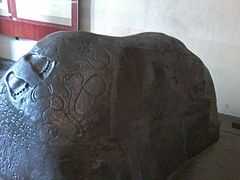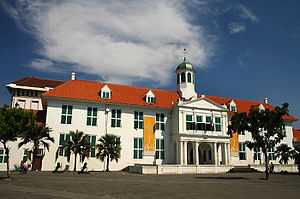Jakarta History Museum
| Jakarta History Museum / Fatahillah Museum / Batavia Museum Museum Sejarah Jakarta | |
|---|---|
|
| |
| Established | 1707 |
| Location | Jl Taman Fatahillah 1, Jakarta Barat, Jakarta, Indonesia |
| Type | History museum |
| Visitors |
69,708 (2006)[1] 75,067 (2007)[1] |
| Public transit access |
|
| Website | Jakarta History Museum |
The Jakarta History Museum (Indonesian: Museum Sejarah Jakarta), also known as Fatahillah Museum or Batavia Museum, is located in the Old Town (known as Kota Tua) of Jakarta, Indonesia. The building was built in 1710 as the Stadhuis (city hall) of Batavia. Jakarta History Museum, opened in 1974, displays objects from the prehistory period of the city region, the founding of Jayakarta in 1527, and through the Dutch colonization period from the 16th century until Indonesia’s Independence in 1948. The museum is located in south side of Fatahillah Square (former Batavia city square) near Wayang Museum and Fine Art and Ceramic Museum. The building is believed to be modeled after Dam Palace.
History

Jakarta History Museum is located in the building which was the former City Hall of Batavia, known in the past as Stadhuis. This building was the administrative headquarters of the Dutch East India Company and later of the Dutch Colonial Government. The current building was constructed in 1707 by the city government, replacing the former city hall built in 1627. Governor General Abraham van Riebeeck inaugurated it in 1710. As the city continue to expand southward, the building's function as city hall (Dutch gemeentehuis) ended by 1913.[2]
After the declaration of Indonesia in 1945, the building was used as West Java governor office until 1961, when Jakarta was declared an independent autonomy. Afterward the building was used as governor office of DKI Jakarta. In 1970, the Fatahillah Square was declared a Cultural Heritage.[3] This effort was the beginning of the development of the historical area of the City of Jakarta, carried out by the Government of DKI Jakarta. The Jakarta History Museum was inaugurated on 30 March 1974 as the center for collection, conservation and research for all kinds of objects of cultural heritage related to the history of the City of Jakarta. The building's generous scale with massive timber beams and floorbands.[4]

Feature
The building contains 37 ornate rooms. There are also some cells located beneath the front portico which were used as dungeons, which function until 1846. A Javanese freedom fighter Prince Diponegoro, who was treacherously arrested, was imprisoned here in 1830 before being banished to Manado, North Sulawesi.
This building is located in front of a public square, which in the past was known as Stadhuisplein, the City Hall Square. The square is now known as Fatahillah Square (Indonesian: Taman Fatahillah). In the center of the square is a fountain which was used as a water supply during colonial era. Also located in the square is a Portuguese cannon (known as Si Jagur Cannon) with a hand ornament showing a fico gesture, which is believed by local people to be able to induce fertility on women. The square was also used as the place of executions.[3]
Collections
Jakarta History Museum has a collection of around 23,500 objects, some of them inherited from de Oude Bataviasche Museum (now the Wayang Museum). The collection includes objects from the Dutch East Indies Company, historic maps, paintings, ceramics, furnitures, and archeological objects from the prehistoric era such as ancient inscriptions and sword. The Jakarta History Museum also contains the richest collection of Betawi style furnitures from the 17th to the 19th century. The collections are divided into several rooms such as Prehistoric Jakarta Room, Tarumanegara Room, Jayakarta Room, Fatahillah Room, Sultan Agung Room, and MH Thamrin Room.[3]
The museum also contains a replica of the Tugu Inscription (the original being in the National Museum) from the age of Great King Purnawarman, which is the evidence that the center of the Kingdom of Tarumanegara was located around the seaport of Tanjung Priok on the coast of Jakarta. There is also a replica of the 16th century map of the Portuguese Padrao Monument, a historical evidence of the ancient Sunda Kelapa Harbor.
-

A stone tablet showing a VOC vessel in a wall of the Jakarta History Museum
-
Replica of Tugu Inscription.
-

Replica of Ciaruteun inscription.
-
Japanese Ceramic pot from 17th century.
-
Unfinished Mural by Harijadi Sumodidjojo.
Conservation
The museum was temporarily closed in July 2011 for conservation. Conservation activities to be conducted with aid from the Dutch government are scheduled to begin in 2012.[5] The renovation was completed in February 2015. A new room named "Conservation room" is added during the renovation, the new section displayed the vision and mission of JOTR (Jakarta Old Town Reborn) for the future of Old Batavia.[6]
See also
- List of colonial buildings and structures in Jakarta
- List of museums and cultural institutions in Indonesia
References
- ↑ 1.0 1.1 Jakarta in Figures. Statistics DKI Jakarta Provincial Office, Jakarta. 2008.
- ↑ Stadhuis
- ↑ 3.0 3.1 3.2 "Jakarta History Museum". Indonesia Tourism. IndonesiaWebPromotion. Retrieved 2009-12-29.
- ↑ Schoppert, Peter; Damais, Soedarmadji & Sosrowardoyo, Tara (1998), Java Style, Tokyo: Tuttle Publishing, p. 39, ISBN 962-593-232-1.
- ↑ 'Fatahillah Museum closed until 2014' The Jakarta Post, 9 July 2011.
- ↑ Mengintip Kelahiran Baru Kota Tua Jakarta, kompas.com, February 13 2015
Literature
- Lenzi, Iola (2004). Museums of Southeast Asia. Singapore: Archipelago Press. p. 200. ISBN 981-4068-96-9.
External links
![]() Media related to Jakarta History Museum at Wikimedia Commons
Media related to Jakarta History Museum at Wikimedia Commons
Coordinates: 6°08′06″S 106°48′47″E / 6.13500°S 106.81306°E



